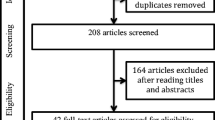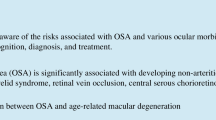Abstract
Patients with obstructive sleep apnea (OSA), in comparison to controls, have increased levels of circulating epinephrine and norepinephrine, both of which are risk factors for the development of central serous chorioretinopathy (CSCR). The aim of this pilot study was to investigate the frequency of symptoms that suggest OSA in CSCR patients and normal controls. The Berlin Questionnaire, a validated research tool to assess risk for OSA, was administered to 29 patients who met the criteria for active, acute, non-steroid-induced CSCR and 29 controls matched for age and sex. In this retrospective case-controlled study, the main outcome measure was increased risk for OSA. The mean age of the patients was 47.8 years (range 29–72) and the mean age of controls was 47.3 years (range 25–70). Seventy-six percent (22) of both groups were men. Survey scores showed 58.6% (17) of patients with CSCR to be at an increased risk for OSA compared to 31.0% (nine) of controls. A conditional logistic regression analysis showed that the CSCR group had a higher proportion with an increased risk for OSA compared to the control group (odds ratio=3.67; 95% CI: 1.02, 13.14; P = 0.046). Patients with CSCR may be more likely than other adults to have OSA, and screening for this sleep disorder should be considered in this population. Further research is warranted to determine whether sleep apnea may contribute to the development of CSCR, and to assess whether treatment of sleep apnea might offer a new therapeutic option for some patients with CSCR.

Similar content being viewed by others
References
Guyer DR et al (1999) Retina-Vitreous-Macula. Saunders, Philadelphia
Yannuzzi LA (1987) Type-A behavior and central serous chorioretinopathy. Retina 7:111–131
Gelber GS, Schatz H (1987) Loss of vision due to central serous chorioretinopathy following psychological stress. Am J Psychiatry 144:46–50
Gass JD (1991) Central serous chorioteinopathy and white subretinal exudation during pregnancy. Arch Ophthalmol 109:677–681
Bouzas EA, Scott MH, Mastorakos G et al (1993) Central serous chorioretinopathy in endogenous hypercortisolism. Arch Ophthalmol 111:1229–1233
Bouzas EA, Karadimas P, Pournaras CJ (2002) Central serous chorioretinopathy and glucocorticoids. Surv Ophthalmol 47:431–448
Carvalho-Recchia CA, Yannuzzi LA, Negrao S et al (2002) Corticosteroids and central serous chorioretinopathy. Ophthalmology 109:1834–1837
Michael JC, Pak J, Pulido J et al (2003) Central serous chorioretinopathy associated with administration of sympathomimetic agents. Am J Ophthalmol 136:182–185
Garg SP, Dada T, Talwar D et al (1997) Endogenous cortisol profile in patients with central serous chorioretinopathy. Br J Ophthalmol 81:962–964
Haimovici R, Rumelt S, Melby J (2003) Endocrine abnormalities in patients with central serous chorioretinopathy. Ophthalmology 110:698–703
Yoshioka H (2003) The etiology of central serous chorioretinopathy. Nippon Ganka Gakkai Zasshi 95:1181–1195
Yoshioka H, Katsume Y, Akune H (1982) Experimental central serous chorioretinopathy in monkey eyes: fluorescein angiographic findings. Ophthalmologica 185:168–178
Fletcher EC (1997) Sympathetic activity and blood pressure in the sleep apnea syndrome. Respiration 64(Suppl1):22–28
Dimsdale JE, Coy T, Ziegler MG et al (1995) The effect of sleep apnea on plasma and urinary catecholamines. Sleep 18:377–381
Elmasry A, Lindberg E, Hedner J et al (2002) Obstructive sleep apnoea and urine catecholamines in hypertensive males: a population-based study. Eur Respir J 19:511–517
McNicholas (2002) Breathing Disorders in Sleep. WB Saunders, London
Fletcher EC, Miller J, Schaaf JW et al (1987) Urinary catecholamines before and after tracheostomy in patients with obstructive sleep apnea and hypertension. Sleep 10:35–44
Grunstein RR, Stewart DA, Lloyd H et al (1996) Acute withdrawal of nasal CPAP in obstructive sleep apnea does not cause a rise in stress hormones. Sleep 19:774–782
O’Connor TM, O’Halloran DJ, Shanahan F (2000) The stress response and the hypothalamic–pituitary–adrenal axis: from molecule to melancholia. QJM 93:323–333
Spath-Schwalbe E, Gofferje M, Kern W et al (1991) Sleep disruption alters nocturnal ACTH and cortisol secretory patterns. Biol Psychiatry 29:575–584
Spiegel K, Leproult R, Van Cauter E (1999) Impact of sleep debt on metabolic and endocrine function. Lancet 354:1435–1439
American Academy of Sleep Medicine (2005) International Classification of Sleep Disorders, 2nd ed.: Diagnostic and coding manual. American Academy of Sleep Medicine, Westchester, Illinois
Netzer NC, Stoohs RA, Netzer CM et al (1999) Using the Berlin Questionnaire to identify patients at risk for the sleep apnea syndrome. Ann Intern Med 131:485–491
Young T, Peppard PE, Gottlieb DJ (2002) Epidemiology of obstructive sleep apnea: a population health perspective. Am J Respir Crit Care Med 165:1217–1239
Haimovici R, Koh S, Gagnon DR et al (2004) Central Serous Chorioretinopathy Case-Control Study Group. Risk factors for central serous chorioretinopathy: a case-control study. Ophthalmology 111:244–249
Phillipson EA (1993) Sleep apnea—a major public health problem. N Engl J Med 328:1271–1273
Shamsuzzaman AS, Gersh BJ, Somers VK (2003) Obstructive sleep apnea: implications for cardiac and vascular disease. JAMA 290:1906–1914
Acknowledgements
Funding of this study was from the University of Michigan Kellogg Eye Center.
Competing interests
None.
Author information
Authors and Affiliations
Corresponding author
Rights and permissions
About this article
Cite this article
Leveque, T.K., Yu, L., Musch, D.C. et al. Central serous chorioretinopathy and risk for obstructive sleep apnea. Sleep Breath 11, 253–257 (2007). https://doi.org/10.1007/s11325-007-0112-3
Published:
Issue Date:
DOI: https://doi.org/10.1007/s11325-007-0112-3




